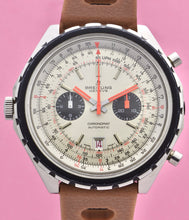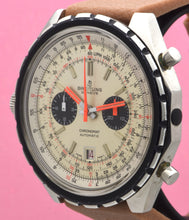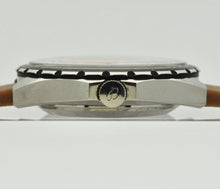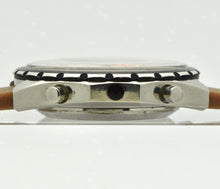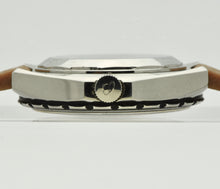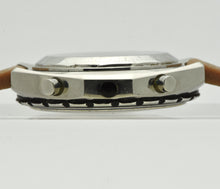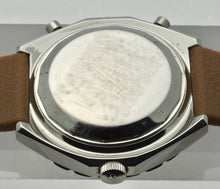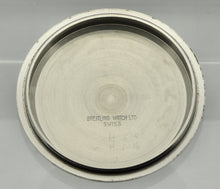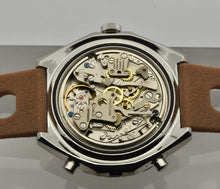
Breitling Chronomat, Ref. 1808, circa 1975. A fine, oversize, self-winding stainless steel chronograph wristwatch with date.
Case: Three-body, screw-down case back. Black revolving bezel with slide rule.
Dial: Two-toned silvered dial with applied silver baton hour markers with luminous tips and contrasting luminous hands with orange tips. 12 hour and 30 minute registers. Date aperture at 6. Signed “Breitling Genève” below 12, and “Swiss Made T” above 6.
Movement: Caliber 11, automatic, engraved “SX”, 17 jewels, self-compensating flat balance spring, monometallic balance, shock absorber. Signed “Breitling Cal 11 Automatic” and “Seventeen 17 Unadjusted Swiss.
Diameter: 47mm, thickness: 15mm.
Condition: A few light scratches on the dial which are imperceptible to the naked eye. Case and bezel are in good condition with some scratches throughout. Caseback has a light engraving around the edge "Nestlé á M. Claude Nussbaumer 1947-1972."
More about Breitling:
By the 1960s, many brands had begun the attempt to create an automatic chronograph movement. Two main groups were competing to develop this first – Movado/Zenith, and Heuer/Breitling/Hamilton/
In 1965, the group of Heuer, Breitling, Hamilton, and Dubois Depraz began working on the project, dubbed “Project 99”, with each company being responsible for a part of the final watch. In 1967, a patent was filed for the caliber 11, and in 1968 the first prototypes were developed. In September of 1968, Breitling manufactured the first Chrono-matic wristwatch.
The design of the caliber 11 in the Chrono-matic was interesting in that it required the winding crown to be located on the opposite side of the chronograph pushers, by 9 o’clock. Since the watch had an automatic movement and would not need to be wound by hand as much, it was decided by the four firms that moving the crown to the opposite side was best.
The “Big Case” or “Pizza” Chronomat, reference 1808, was among Breitling’s earliest offerings with the new Chronomatic caliber 11. The first pieces were fitted with caliber 11, which were then discontinued in favor of the caliber 12.









